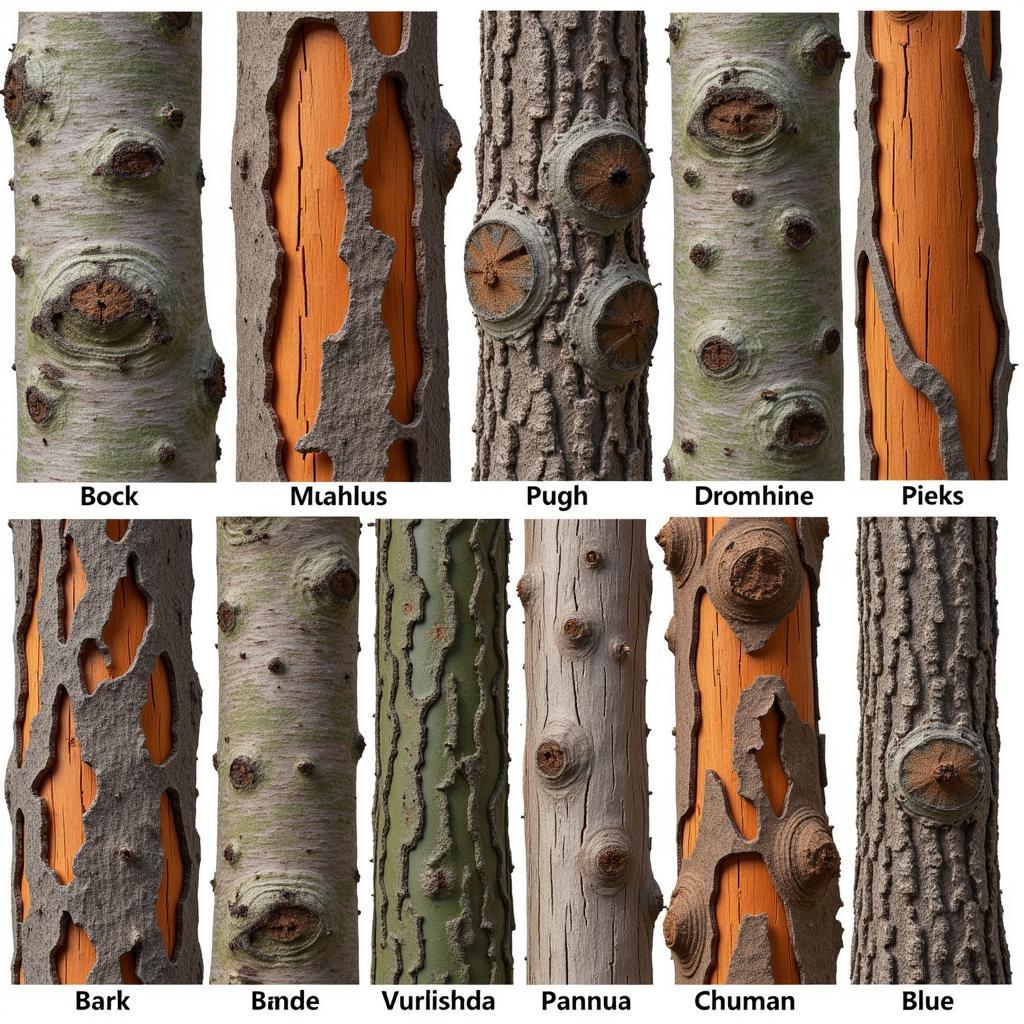Bark, the protective outer layer of trees, isn’t just brown. It’s a surprisingly diverse world of color, texture, and even scent. Understanding what color bark is involves exploring the nuances of tree species, age, and environmental factors. This article delves into the fascinating world of bark color, uncovering the reasons behind its variations and offering insights into how to appreciate its beauty.
Can you color almond bark might be something you’re interested in if you’re working with a different kind of bark altogether.
Decoding the Hues of Tree Bark
While brown is the most common color associated with bark, a closer look reveals a spectrum of shades from pale cream and silvery gray to deep reddish-brown and almost black. These variations are not random; they result from a complex interplay of factors, including the tree species, its age, and the environment in which it grows.
The Role of Tree Species in Bark Color
Different tree species have unique bark characteristics, including color. For example, the paper birch (Betula papyrifera) is renowned for its striking white bark, while the black cherry (Prunus serotina) displays a dark, almost black bark. These differences arise from the specific chemical composition and structure of the bark.
Age and Environmental Influences
As trees mature, their bark often changes color. Young trees may have smoother, lighter-colored bark that darkens and develops textures like furrows and ridges as they age. Environmental factors such as sunlight exposure, moisture levels, and even air pollution can also influence bark color. For example, trees exposed to intense sunlight may develop darker bark as a form of protection.
Can you put food coloring in almond bark is a common question for those working with confections.
Beyond Brown: Exploring the Spectrum of Bark Colors
Bark color can be incredibly diverse, encompassing a range of hues that extend far beyond the typical browns.
The Whites and Grays
White and gray bark colors are often associated with trees like birch, aspen, and sycamore. These lighter colors can reflect sunlight, helping to regulate the tree’s temperature and prevent overheating.
The Reds and Oranges
Certain tree species, such as the madrone and ponderosa pine, exhibit reddish or orange hues in their bark. These colors can be attributed to pigments within the bark tissue.
The Blacks and Dark Browns
Darker bark colors, like those seen in black cherry and walnut trees, are often associated with thicker, more protective bark layers.
“The diversity of bark color is a testament to the adaptability of trees,” says Dr. Amelia Wood, a leading botanist. “Each shade and texture tells a story about the tree’s species, age, and the environment it thrives in.”
Why is Bark Color Important?
Bark color plays a crucial role in the survival and health of trees. It provides protection against environmental stressors like excessive sunlight, temperature fluctuations, and pests. The color can also influence the tree’s ability to absorb and reflect heat, which is essential for regulating its internal temperature.
Can you color almond bark with food coloring offers a way to customize your culinary creations.
Identifying Trees by Bark Color
Bark color, along with other characteristics like texture and pattern, can be a helpful tool for identifying different tree species. Field guides and online resources often use bark color as a key identifying feature.
“Observing bark color is like reading a tree’s fingerprint,” notes seasoned arborist, Samuel Branch. “It’s a unique characteristic that reveals valuable insights into the tree’s identity and history.”
 Identifying Trees Using Bark Color and Texture
Identifying Trees Using Bark Color and Texture
How to add food coloring to almond bark is a useful skill for bakers and confectioners.
Conclusion
What color is bark? It’s a question with a multifaceted answer. Bark color is more than just brown; it’s a dynamic and diverse characteristic influenced by species, age, and environment. By understanding the factors that contribute to bark color, we can appreciate the intricate beauty and vital role of this protective layer in the lives of trees.
Can i add food coloring to almond bark is another question often asked by home cooks.
FAQ
- What is the most common bark color? Brown is the most prevalent bark color.
- Why is birch bark white? The white color of birch bark is due to a compound called betulin, which reflects sunlight and protects the tree.
- Can bark color change over time? Yes, bark color can change as a tree ages and is exposed to different environmental conditions.
- How can I identify a tree by its bark? Use field guides or online resources that describe bark color, texture, and patterns.
- Why is bark important for trees? Bark protects trees from environmental stressors like sunlight, temperature changes, and pests.
Need support? Contact us at Phone: 0373298888, Email: [email protected] or visit our address: 86 Cau Giay, Hanoi. We have a 24/7 customer service team.

